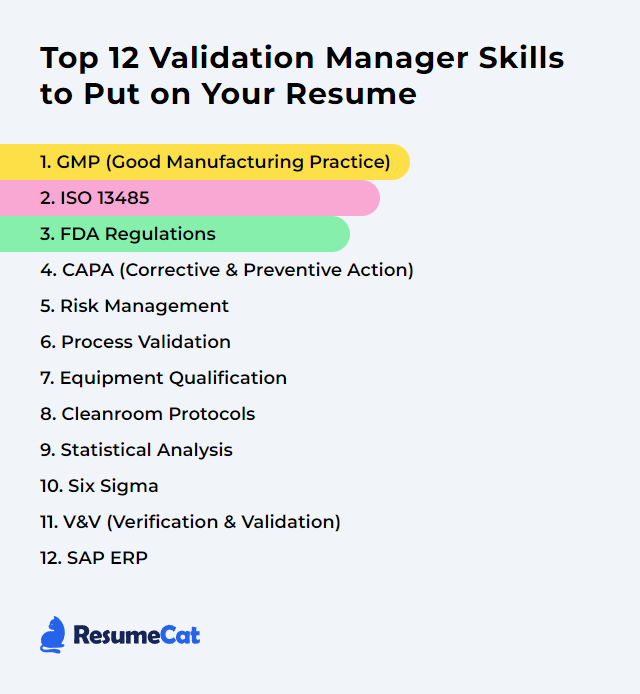Top 12 Validation Manager Skills to Put on Your Resume
In today's crowded hiring landscape, a standout Validation Manager resume hinges on the right mix of skills. Not just buzzwords—real capability, clearly shown. When you master and spotlight the essentials, you raise your odds for interviews, promotions, and the kind of roles where you set the standard, not just meet it.
Validation Manager Skills
- GMP (Good Manufacturing Practice)
- ISO 13485
- FDA Regulations
- CAPA (Corrective and Preventive Action)
- Risk Management
- Process Validation
- Equipment Qualification
- Cleanroom Protocols
- Statistical Analysis
- Six Sigma
- V&V (Verification and Validation)
- SAP ERP
1. GMP (Good Manufacturing Practice)
GMP is the backbone of consistent, controlled production. It’s the framework that ensures processes, systems, and equipment deliver products that meet defined quality requirements—day after day, batch after batch. For a Validation Manager, it means proof, not promises: documented confidence that what you run works as intended.
Why It's Important
GMP protects patient safety, product quality, and the company’s reputation. It reduces risks that can’t be caught by testing alone. Compliance here isn’t optional; it’s the cost of entry.
How to Improve GMP (Good Manufacturing Practice) Skills
GMP maturity grows through discipline and iteration. Focus on:
Training and Competency: Build role-based training that sticks. Refresh it regularly. Verify competency, don’t assume it.
Documentation: Tighten SOPs. Make records clear, contemporaneous, attributable, and retrievable. Data integrity every time.
Validation and Qualification: Keep protocols current with evolving standards. Review DQ/IQ/OQ/PQ cycles on a defined cadence, with risk front and center.
Risk Management: Use structured methods (e.g., FMEA) to hunt down failure modes early. Prioritize critical controls.
Continuous Improvement: Internal audits, management review, CAPA trends—mine them. Build a quality management system that breathes, not one that gathers dust.
Supplier Oversight: Qualify, audit, monitor. Extend GMP expectations across the supply chain, not just your four walls.
Technology: Adopt electronic batch records, environmental monitoring, and automation where they sharpen control and traceability.
Do this well and you’ll see fewer deviations, smoother inspections, and sturdier outcomes.
How to Display GMP (Good Manufacturing Practice) Skills on Your Resume

2. ISO 13485
ISO 13485 defines requirements for a medical device quality management system across design, development, production, and distribution. For Validation Managers, it shapes how you plan, execute, and maintain validation to meet regulatory and customer expectations without flinching.
Why It's Important
It aligns your QMS to global regulatory needs, drives consistency, and anchors risk management, traceability, and documentation—key pillars for device safety and effectiveness.
How to Improve ISO 13485 Skills
Embed Risk Management: Integrate risk thinking throughout the lifecycle. Align with ISO 14971 (2019, Amd 1:2022) principles for hazard identification and control.
Documentation and Records: Keep procedures crisp and records complete. Control changes tightly. Make audits painless because your files tell a clean story.
Verification and Validation: Strengthen process, product, and software validation. Define acceptance criteria up front. Confirm suitability and reproducibility.
Supplier Controls: Qualify, segment by risk, and monitor. Contracts and quality agreements should spell out the rules of the road.
Continuous Improvement: Leverage CAPA, trending, and management reviews. Treat nonconformities as tuition—learn and reduce recurrence.
Training: Keep teams fluent in ISO 13485:2016 requirements and related regulations (e.g., EU MDR 2017/745, 21 CFR 820).
Regulatory Awareness: Track updates and guidance across target markets. Harmonize local requirements into your QMS without clutter.
Audit Readiness: Run internal audits like the real thing. Calibrate findings. Close gaps with evidence, not just intent.
How to Display ISO 13485 Skills on Your Resume
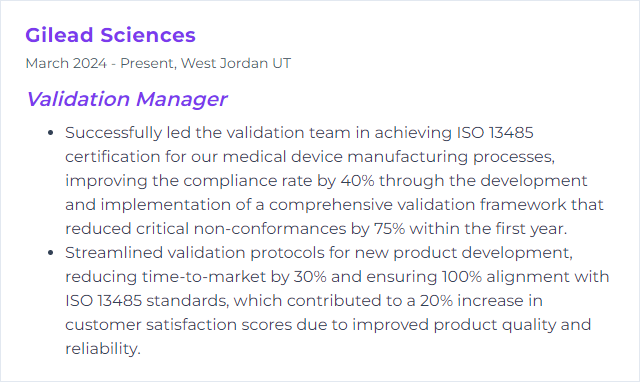
3. FDA Regulations
FDA regulations set the guardrails for drugs, biologics, devices, and more. For Validation Managers, they demand documented, science-based evidence that processes, systems, and equipment perform reliably and consistently against defined specs.
Why It's Important
Compliance protects patients and preserves trust. It also drives robust process understanding, data integrity, and inspection readiness. Miss the mark and the cost can be severe.
How to Improve FDA Regulations Skills
Master the Foundations: Know the relevant parts of 21 CFR (e.g., 210/211 for drugs, 820 for devices, Part 11 for electronic records). Understand what’s required—and why.
Use a Risk-Based Lens: Apply quality risk management (e.g., ICH Q9(R1)) to prioritize what matters most to patient safety and product quality.
Strengthen Validation Strategy: Align protocols with current FDA guidance, define acceptance criteria clearly, and justify sampling and statistics. Close deviations with factual root causes.
Data Integrity: Build ALCOA+ practices into systems and habits. Audit trails, access control, contemporaneous recording—nonnegotiable.
Stay Current: Track guidance updates, inspection trends, and warning letter themes. Adjust procedures before gaps become findings.
Inspection Readiness: Practice mock inspections, stage documents, and coach SMEs. Clarity beats volume.
How to Display FDA Regulations Skills on Your Resume
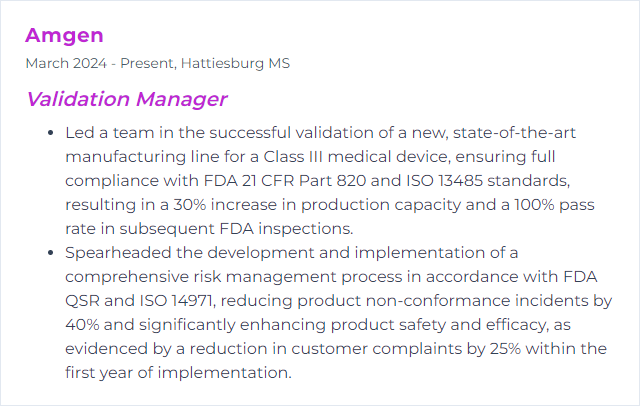
4. CAPA (Corrective and Preventive Action)
CAPA is the engine of learning. It identifies root causes, corrects what went wrong, and prevents repeats. For Validation Managers, it’s how validation issues become durable improvements instead of recurring headaches.
Why It's Important
It protects quality, reduces risk, and shows regulators you don’t just react—you improve. Patient safety gets stronger. Compliance follows.
How to Improve CAPA (Corrective and Preventive Action) Skills
Root Cause Analysis: Use structured tools (5 Whys, fishbone, fault tree). Separate symptoms from causes. Validate the root before jumping to fixes.
Risk Prioritization: Rank by severity, occurrence, and detectability. Focus energy where harm could be highest.
Action Planning: Write clear, time-bound actions with owners and measurable outcomes. SMART, but practical.
Effectiveness Checks: Verify results with data. Did the risk score drop? Did the defect disappear across lots, lines, and shifts?
Documentation and Communication: Tell the story cleanly—problem, cause, fix, proof. Share lessons with stakeholders who need to know.
Training: Close knowledge gaps unearthed by CAPA. Reinforce behaviors that prevent recurrence.
Systemic Improvement: Trend CAPA data. Find patterns, attack systemic failures, and update procedures and controls.
How to Display CAPA (Corrective and Preventive Action) Skills on Your Resume

5. Risk Management
Risk Management means spotting threats early, sizing them up, and building controls that hold. In validation, it’s your compass—guiding what to test, how deeply, and where to watch.
Why It's Important
It keeps resources aimed at the highest-impact risks, trims surprises, and strengthens compliance. Better focus, better outcomes.
How to Improve Risk Management Skills
Define the Landscape: Technical risks, compliance risks, data risks—map them. Clarify risk acceptance criteria up front.
Use Proven Tools: Apply FMEA, fault tree analysis, or hazard analysis. Build risk registers that actually drive decisions.
Prioritize Ruthlessly: Use a severity/occurrence/detection framework. Not all risks deserve the same attention.
Mitigate Smartly: Choose controls that are proportionate and sustainable—engineering controls before administrative ones when possible.
Monitor Continuously: Reassess when processes change, when deviations spike, or when regulations shift.
Document Transparently: Record rationale, controls, and residual risk. Make it easy to explain during audits.
Build Culture: Encourage early escalation and open discussion. Reward prevention, not heroics.
How to Display Risk Management Skills on Your Resume
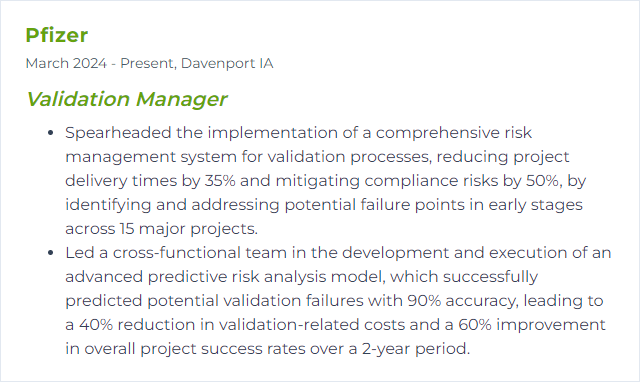
6. Process Validation
Process Validation is the documented proof that a process is capable—reproducible, controlled, and fit for purpose. It’s not a one-time ritual; it’s lifecycle thinking.
Why It's Important
It underpins product quality and regulatory confidence. When processes are understood and controlled, deviations shrink and patients stay safe.
How to Improve Process Validation Skills
Align to Current Guidance: Follow lifecycle principles (process design, qualification, continued process verification). Keep your approach current.
Risk-Based Design: Let risk assessments drive study depth, sampling, and controls. Focus on critical quality attributes and critical process parameters.
Design of Experiments (DoE): Use DoE to map interactions, define design space, and harden control strategies.
Cross-Functional Input: Manufacturing, QA, QC, engineering—pull them in early. Better designs come from diverse brains.
Continued Process Verification: Monitor signals with SPC and trending. Detect drift before it turns into scrap.
Training: Keep teams current on statistical tools, sampling logic, and documentation expectations.
Digital Tools: Use validation management systems to enforce workflows, trace decisions, and protect data integrity.
Post-Mortems: After each campaign, review what worked and what wobbled. Feed lessons back into protocols.
Documentation Excellence: Clear protocols, unambiguous acceptance criteria, defensible rationales. Let the file defend itself.
Stakeholder Communication: Communicate risks, plans, and outcomes succinctly. No fog, just facts.
How to Display Process Validation Skills on Your Resume
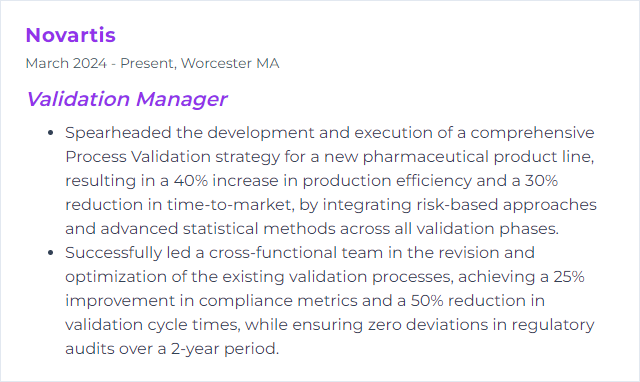
7. Equipment Qualification
Equipment Qualification proves equipment is fit for intended use—installed correctly, operating within spec, and delivering consistent performance. The usual arc: DQ, IQ, OQ, PQ.
Why It's Important
It’s how you ensure reliable output and regulatory compliance. When the tools are sound, the process can be too.
How to Improve Equipment Qualification Skills
Start with Clear Requirements: Define user requirements and functional specs meticulously. Ambiguity here becomes pain later.
Risk-Based Focus: Concentrate testing on functions that affect product quality and patient safety. Don’t over-test the trivial.
Robust Qualification Plans: Spell out methods, ranges, challenges, and acceptance criteria for each phase (DQ/IQ/OQ/PQ). Justify your sampling and challenges.
Training and Calibration: Ensure operators and maintainers are trained. Keep calibration schedules tight and traceable.
Documentation Discipline: Capture results, deviations, investigations, and impact assessments crisply. Auditors should find a straight line.
Leverage Frameworks: Apply guidance such as GAMP 5 for computerized systems and Commissioning & Qualification best practices for complex assets.
Requalification Strategy: Set triggers—time-based, change-based, or performance-based. Reassess when risk says so.
How to Display Equipment Qualification Skills on Your Resume
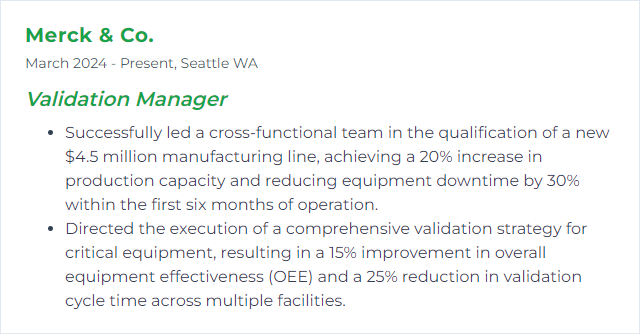
8. Cleanroom Protocols
Cleanroom protocols preserve controlled environments—minimizing particulates, microbes, and other contaminants. Validation Managers confirm the space and the behaviors inside it meet defined classifications and hold the line over time.
Why It's Important
Because contamination doesn’t forgive. Strong protocols protect product integrity, patient safety, and regulatory standing.
How to Improve Cleanroom Protocols Skills
Keep SOPs Current: Update gowning, cleaning, material transfer, and equipment operation procedures to reflect standards (e.g., ISO 14644 series) and inspection learnings.
Train Relentlessly: Behavior matters—movement, talking, glove changes, aseptic technique. Reinforce with observation and feedback.
Monitor and Validate: Use environmental monitoring programs with meaningful action/alert levels. Requalify rooms on schedule and after changes.
Maintain Equipment: HEPA, differential pressure, temperature, humidity—maintain and verify. Small drifts can become big problems.
Audit and Improve: Walk the floor. Audit practices. Capture near-misses. Tighten weak spots quickly.
Control Entry: Qualify materials and tools before they cross the line. Reduce bioburden at the door.
Incident Response: Define thresholds, investigate excursions promptly, and trend the events to prevent repeats.
How to Display Cleanroom Protocols Skills on Your Resume
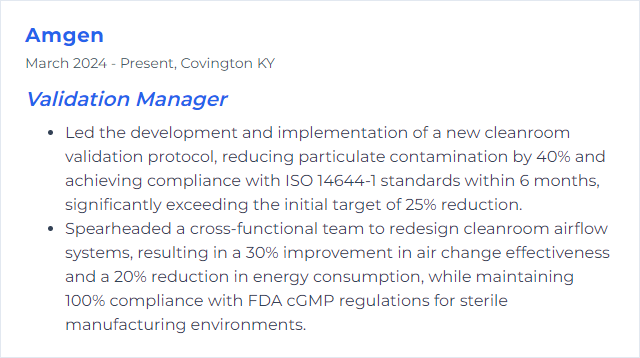
9. Statistical Analysis
Statistics turns noise into signal. It helps you understand variation, compare groups, build models, and make defensible decisions. In validation, it’s the difference between guessing and knowing.
Why It's Important
Regulators expect evidence, not anecdotes. Statistical rigor supports sampling plans, capability assessments, stability studies, and effectiveness checks.
How to Improve Statistical Analysis Skills
Know Your Data: Understand sources, distributions, and limitations. Choose methods that match the question and the data type.
Use the Right Tools: Regression, ANOVA, nonparametrics, capability indices, SPC—pick the right instrument for the job.
Validate Your Models: Apply cross-validation, holdout sets, or bootstrapping where appropriate. Trust, but verify.
Elevate Data Quality: Tighten collection methods, handle missingness systematically, and treat outliers with reason, not reflex.
Stay Current: Refresh skills in experimental design, Bayesian thinking where applicable, and visualization best practices.
Communicate Clearly: Translate stats into plain language. Decision-makers need the “so what” as much as the p-value.
Adopt Solid Software: Use well-supported tools (e.g., R, Python, Minitab) and standardize code reviews and templates for repeatability.
Quality Controls: Peer review analyses, lock templates, and version models. Reproducibility is part of compliance.
How to Display Statistical Analysis Skills on Your Resume
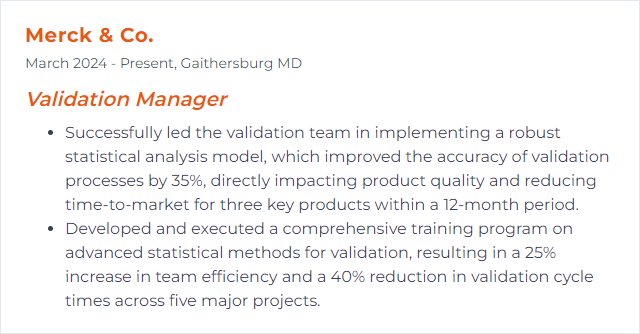
10. Six Sigma
Six Sigma is a data-driven method to cut defects and reduce variation. For Validation Managers, it sharpens process understanding and hardens control plans using DMAIC or DMADV as the playbook.
Why It's Important
It boosts quality, trims waste, and aligns improvements with what customers actually value. Less rework, fewer surprises.
How to Improve Six Sigma Skills
Build Capability: Train teams in DMAIC/DMADV. Define roles (Green Belt, Black Belt) and sponsor projects with clear charters.
Blend with Lean: Pair variation reduction with waste elimination. Map value streams and remove bottlenecks that feed defects.
Use Statistical Muscle: Apply tools like hypothesis testing, regression, and design of experiments. Software such as Minitab or SigmaXL helps, but method matters more.
Voice of the Customer: Convert needs into critical-to-quality attributes. Target improvements where they move the needle.
Strengthen Validation: Bake Six Sigma logic into validation—better sampling, clearer acceptance criteria, stronger control strategies.
Audit the Cycle: Review projects regularly. Sustain gains with control plans and visual management.
Cultivate Culture: Recognize wins, share case studies, and make improvement part of daily work, not side work.
How to Display Six Sigma Skills on Your Resume
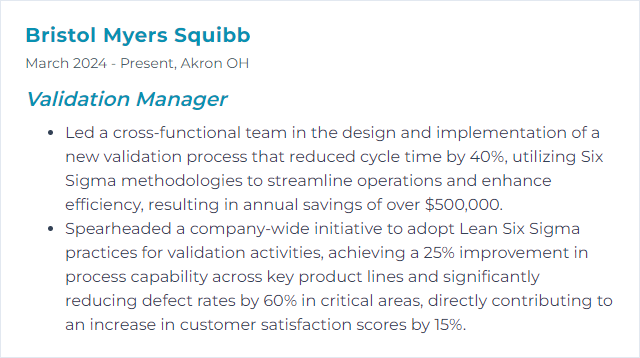
11. V&V (Verification and Validation)
Verification checks whether you built the product right. Validation checks whether you built the right product. Together, V&V ensure requirements are met and intended use is served, safely and reliably.
Why It's Important
It reduces rework, ensures traceability from requirements to evidence, and anchors compliance. Products work as promised—and as needed.
How to Improve V&V (Verification and Validation) Skills
Set Clear Objectives: Define measurable acceptance criteria early. Tie them to risk and intended use.
Standardize: Establish templates for plans, protocols, and reports. Reuse what works. Calibrate across teams.
Automate Where Sensible: For software, use automated testing frameworks. For equipment and process, standardize test rigs and data capture.
Train the Team: Keep methods fresh—requirements management, test design, traceability matrices, and defect triage.
Engage Stakeholders Early: Pull in users and customers to validate needs before build decisions harden.
Review and Audit: Periodic reviews catch drift. Independent eyes find blind spots.
Feedback Loops: Capture lessons from failures and passes alike. Update checklists and templates accordingly.
Integrate Risk: Link tests to risk controls. Prove that mitigations actually mitigate.
How to Display V&V (Verification and Validation) Skills on Your Resume
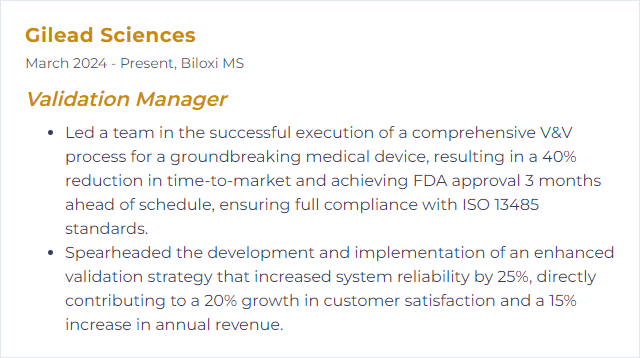
12. SAP ERP
SAP ERP ties together finance, supply chain, manufacturing, quality, HR—the works. For Validation Managers, it centralizes processes and records, supporting compliance, traceability, and consistent execution.
Why It's Important
It enforces standard processes, reduces manual errors, and improves data integrity. One source of truth beats scattered spreadsheets every time.
How to Improve SAP ERP Skills
Data Integrity First: Establish master data governance and periodic audits. Validate critical fields and interfaces.
Automate Repetition: Use workflow and RPA where it’s stable and high-volume. Free people for higher-value checks.
Performance Monitoring: Track job runtimes, interface health, and error rates. Fix bottlenecks fast.
Train Continuously: Role-based training with simulations and job aids. Refresh on release changes and new features.
Compliance and Security: Implement role-based access, electronic signatures, and audit trails. Test controls routinely.
Smart Integration: Connect SAP with LIMS, MES, QMS, and DMS systems using well-governed interfaces. Validate integrations end-to-end.
How to Display SAP ERP Skills on Your Resume

